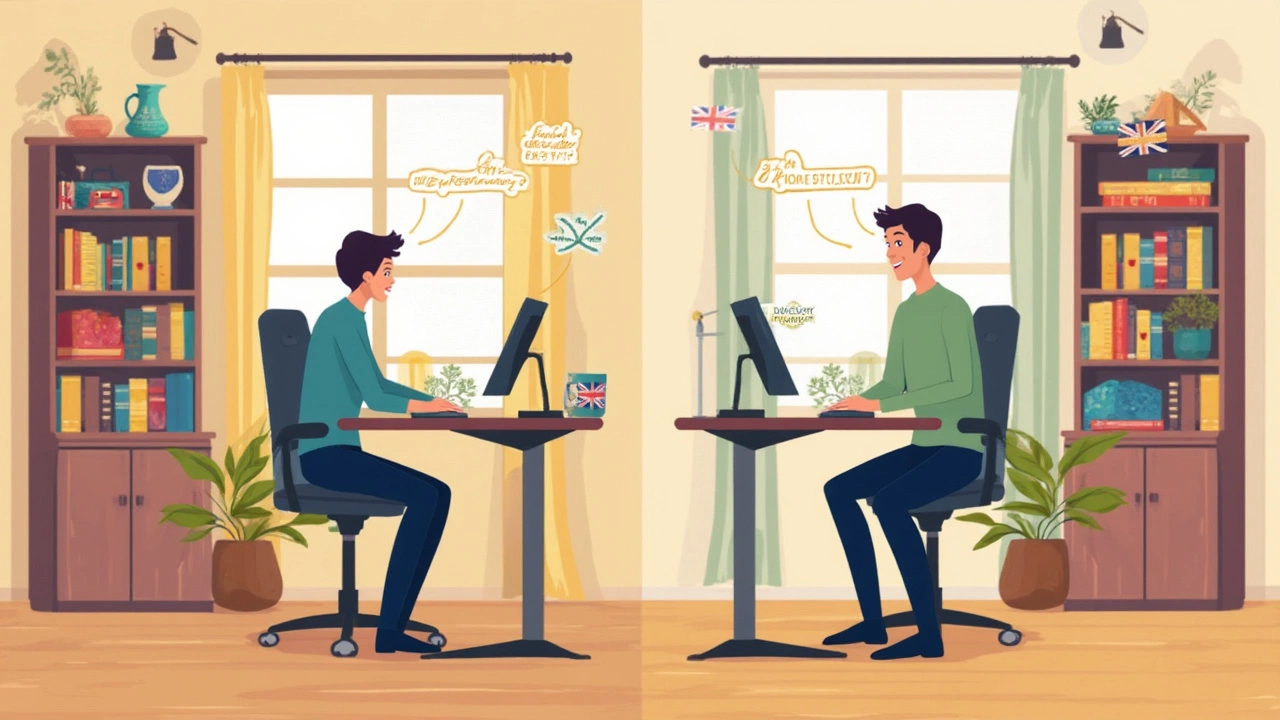Picture yourself glued to a chair for eight, maybe ten hours a day, shoulders hunched, back complaining, eyes barely blinking away from the screen. That’s reality for loads of remote workers—and it's no secret that it can do a number on your body and mind. So, when standing desks burst onto the scene with promises of better health and more energy, people jumped at them like a miracle cure. But are these setups truly worth squeezing into your home office, or is it just a clever fad that will end up gathering dust next to that abandoned exercise bike?
The Hype and Hard Facts Behind Standing Desks
Standing desks aren’t some new Silicon Valley obsession. They’ve been around for centuries—Charles Dickens supposedly did a ton of his writing at a tall desk, and Ben Franklin built his own. It might sound old-school, but today’s pitch is ultra-modern: stand more, sit less, and you’ll shake off the hazards of a desk-bound life. Experts love to quote research from 2015 published in the European Journal of Preventive Cardiology that linked sitting too much to higher risk of heart problems, diabetes, and even certain cancers. On average, full-time desk workers still park it for 9-10 hours most days. Standing desks entered the chat as the rescue squad for your aching spine—touting reduced back pain, better posture, and even more calories burned without breaking a sweat.
Here’s where things get interesting. University College London ran a 12-month trial, giving standing desks to school teachers. At the end, back pain reports dropped by 50%. Another meta-analysis from the CDC (yes, they care about your office chair, too) showed people reduced lower back discomfort and reported feeling less fatigued. It’s not all flawless, though. Some studies warn that just standing all day can be just as rough—think aching feet, swollen ankles, or even varicose veins. The real win is in mixing things up—stand for a while, sit for a while, move as much as possible. Still, standing desks have a fan base for a reason: you can actually feel a difference after a few weeks. Your joints make less noise when you greet the morning; you stop feeling like a T-Rex every time you try to stretch.
But before emptying your wallet, it’s worth noting that standing desks don't magically turn you into a health god overnight. The University of Waterloo found in 2017 that two hours a day is the sweet spot—beyond that, productivity and focus can dip once you get fidgety or tired. Balance really is the magic word with these things.
Work Smarter, Not Just Taller: Productivity and Comfort Challenges
The promise of laser focus from a standing perch is pretty tempting, right? The truth is, your energy might spike at first—standing gets the blood going, keeps your muscles a bit more active. One real-world tip from seasoned remote workers: don’t just stand still for the sake of it. Try moving gently, like shifting your weight, pacing while taking phone calls, or stretching your calves mid-email blast. It feels weird at first, but it works. The Danish National Research Centre for the Working Environment found that workers who alternated standing and sitting reported better focus and less afternoon slump than those who sat all the time. Anecdotally, you really do notice a difference after a week or two.
But if you’re thinking a standing desk turns you into a productivity machine by default, pump the brakes. Fatigue creeps up faster than you think, especially if you jump from zero to marathon standing. Some folks admit the novelty wears off fast, and then it becomes another thing you forget to use. Others swear by using timers—Pomodoro-style—reminding themselves to stand every half hour for 5-10 minutes. The idea isn’t to torture yourself, but to keep your body guessing and avoid that numbing soreness. The American Chiropractic Association actually suggests starting with just 30 minutes a day, then ramping up as your comfort builds.
Don’t ignore comfort, either. If your current office chair is a glorified dining chair, you'll need some upgrades for standing, too. Cheap standing desks can wobble; overly tall ones put your wrists at weird angles. A shocking number of people end up with wrist pain or shoulder tension when their setup is off by even a couple centimeters. Pro tip: measure the height so your forearms are level with the desk, and the top of your monitor is at eye level. Get a cushioned anti-fatigue mat for your feet, and realize that your favorite slippers might not cut it for long stretches. Before you know it, you’ll notice your daily work ritual shifting, and that’s half the battle in staying energized at home.

What to Buy—and What Actually Matters for Your Home Office
So, you’ve made the call: you’re ready to see if a standing desk is a game-changer, or just another forgotten fitness gadget. The avalanche of choices is real, and it’s easy to get lost in the hype. Start with your real needs. Do you want to stand all the time, or do you just want the option? Electric models adjust heights smoothly at the press of a button. Crank versions will save you cash, but you’ll be hand-cranking every time you swap. Desktop converters are a popular budget hack—they sit on top of your existing desk and let you lift your keyboard and monitor with the squeeze of a handle. You don’t have to nuke your current workspace if it’s already organized just right.
There are other bells and whistles, too. Some brands sell built-in charging ports, cable trays, or even programmable settings for your favorite heights. It’s fun but easy to overspend. Read reviews—really read them. Focus on build quality, motor noise (if electric), and warranty. Some desks start wobbling fast, especially if you’re typing hard or leaning on the edges. You want stability for that price tag. Make sure the desk isn’t too shallow—deep enough for your monitor, keyboard, and a notepad, at least. If you’re tight on space, measure the desk footprint twice. No one likes a desk jammed against a doorway, trust me. Monitors need to be adjustable, so invest in an arm or riser if needed. A single, adjustable ergonomic chair paired with your new desk is plenty; you don’t need some futuristic stool.
- Test drive: If you can, try out a friend’s or see if a local office supply store lets you demo one.
- Height range: Don’t buy a model that tops out lower than your elbows when standing.
- Weight capacity: Especially if you use multiple monitors or heavy equipment.
- Noise level: If the motor’s loud, it’ll bug you during every Zoom call.
- Cord management: Stick-on cable trays can keep everything tamed.
- Return policy: Some stores let you test it at home for 30 days. Handy if you’re on the fence.
One secret weapon: split mats or modular flooring if you have hardwood. It gives feet and backs a break. Oh, and for shoes—many opt for basic sneakers indoors, since bare feet sometimes get sore. Even standing barefoot all day isn’t always ideal.
Standing Desk Life: Day-to-Day Tips for Real Home Offices
The adjustment period is like learning to ride a bike: a little wobbly at first, but it pays off. Start with small, regular intervals. Try standing for 20-30 minutes every hour, then find your own rhythm. Listen to your body. Soreness means ease up; a little stiffness is normal. The most common complaint is sore feet the first week. Use that anti-fatigue mat, and don’t forget to shift your weight from side to side or do some small stretches when emails are slow.
Invest in cable management from day one. Tripping over cords or pulling laptops off the desk is more common than you’d think when you’re standing. Another tip: always keep a small footstool handy. Propping one leg up switches up your posture and relieves lower back pressure—a trick taken straight from mild lower back rehab routines. If standing shoes are a new thing, keep a dedicated comfy pair by your desk to avoid dirt and wear on your home floors.
Don’t forget hydration. You’ll feel thirstier standing, and it keeps headaches at bay. Also, if you’re shy about video calls, arrange your desk so you don’t have your back to a window—it avoids weird camera glare and backlighting issues. For those who get chilly standing, a thin pair of wool socks can make a huge difference and keeps you feeling cozy if your office is in the basement or attic.
Routine makes it last. Some people even keep sticky notes as reminders: ‘Stand up’, ‘Stretch’, or ‘Take a walk’. There’s an actual term for this: microbreaks. They work wonders for your head and body, and they add up across weeks and months. Keep variety in your workflow: maybe do creative tasks standing, then handle repetitive work sitting. Studies—like the big one from Texas A&M in 2018—back up that even a modest increase in standing is linked to sharper alertness and task engagement when compared to prolonged sitting.
If you’re on the tall or short side, look for desks with a wide height range. Try before you commit, if possible. If you share your space (kids, spouse, roommates), figure out a standing-only zone to avoid accidental ‘bump and crash’ incidents. And please, treat standing as a tool, not a punishment. If you dread it, you’ll end up resenting both your desk and your work.
At the end of the day, standing desks aren’t magic—but they’re a simple, real upgrade for plenty of home offices. They nudge you out of autopilot, get you moving, and help you build healthier habits. And that’s worth a lot, especially for anyone who sits for hours on end without even thinking about it.






